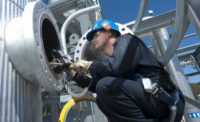Options for short-term gas detector needs

- Options to ensure each worker is equipped with a gas detector during a turnaround, and why renting might be your best option.
According to the American Petroleum Institute, a turnaround is a planned, periodic shutdown (total or partial) of a refinery process unit or plant to perform maintenance, overhaul and repair operations and to inspect, test and replace process materials and equipment. With a turnaround comes an often increased workforce requiring gas detection to keep them safe from gas hazards including oxygen deficiency, combustible gases (typically displayed as LEL), carbon monoxide, hydrogen sulfide, sulfur dioxide and VOCs.
To meet this need, companies are faced with making a decision: should they buy or rent portable gas detection equipment?
A common error that people make when making this decision is that they consider the upfront costs while ignoring the long-term, unforeseen costs — the portion of the iceberg that is hiding underneath the surface. Along with the initial cost of purchasing gas detectors are several other factors that are often not considered related to ownership.
Disposable detectors
One option is to purchase “disposable” gas detectors. There are some very attractive, low-cost disposable gas detectors available in the market today. On the surface, choosing to purchase disposable units might look like a good option, but be sure to consider the following factors before making that decision.
- Taxes — Purchasing a piece of gas detection equipment is considered a capital expense and must be treated as such at tax time. The entire expense of that purchase cannot be deducted during the year in which it was purchased. The capital costs are amortized or depreciated over the useful life of the piece of equipment.
- Disposal costs — A typical cost to properly dispose of a single-gas monitor is upwards of $75.00 each. Batteries, boards and sensors must all be disposed of separately. This involves labor related to disassembly, collection and paperwork, as well as packaging costs and disposal fees.
Expanding your fleet
Another option is to purchase non-disposable gas detectors to be added to your typical fleet of gas detectors. In this case, companies assume responsibility internally for the maintenance of the instruments. Here are a few things to consider before purchasing extra gas detectors:
- Labor costs — Bump tests, calibrations and sensor replacements are some of the time-intensive maintenance tasks associated with portable
- gas monitors.
- Service training — To service the instruments, both time and money are required in training employees to do so.
- Purchasing parts — With a purchase comes the actual cost of parts and pieces, plus taxes.
- Freight charges — To have the parts shipped, freight and additional expenses are required.
- Logistics — Creating an order for parts can be a time-consuming task that should be accounted for.
- Storage costs — There are costs associated with storing parts to be used in the servicing of the instruments.
Third-party maintenance
Another option is to purchase additional gas detectors for use in the turnaround, and then use a third-party to perform the maintenance of those instruments. Here, too, are frequent and unforeseen costs:
- Third-party service fees — The costs of third-party servicing can be high.
- Parts — All parts and pieces associated with instrument repair must be purchased.
- Freight charges — To have the parts shipped, freight and additional expenses are required.
- Logistics — Creating an order for port can be a time-consuming task that should be accounted for.
- Instrument downtime — When an instrument is being serviced, you are typically without the equipment for one week, at a minimum.
Renting equipment
You may choose to rent gas detection equipment for your next turnaround and other short-term needs such as in outages, emergencies, special projects, etc. Expenses and maintenance burdens associated with the aforementioned options for equipping workers with gas detectors during turnarounds are eliminated. But not all gas detector rental programs offer the same benefits. Be sure to scope out the project and ask the right questions:
- When does the rental period start, and when does it end? Some rental companies start the clock the day the equipment leaves their facility; others start it the day it is received. Similarly, the end date could either be when the equipment leaves your facility or when it is received by the rental company.
- What is included with the gas detectors? For example, if you are getting a monitor with a rechargeable battery, ask if the charger will be included. If you are getting a detector with a sampling pump, ask if the sample tubing and filter will be included.
- What gas detector accessories would be ideal for a given application? If you are not sure about the application and the best accessories for the job, ask the rental company about accessories that might make the job easier.
- Do I need to pay for sensors that fail while in use? Some rental companies make up the internal expenses of maintaining their rental fleet by charging customers for sensors that fail while in use, even if the sensors fail due to normal use.
- How will freight charges be handled? If the equipment is being shipped to the job site, find out how the freight will be charged. Some rental companies may issue pre-paid return labels with the order so that the customer does not pay the return freight charges.
- Are the monitors pre-calibrated? Ask to have calibration certificates provided with each rental unit.
- Are the rental units serviced by factory-trained technicians?
- Will normal wear and tear be covered by the cost of the rental?
There are many options to ensure that an increased workforce during a shutdown is properly protected from hazardous gases. Renting gas detection equipment can be a cost-effective and efficient way to keep workers safe. Consider the unseen costs of purchasing gas monitors versus renting them for short-term needs such as turnarounds.
Looking for a reprint of this article?
From high-res PDFs to custom plaques, order your copy today!








